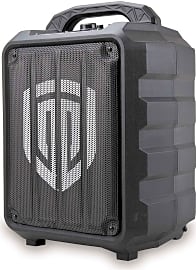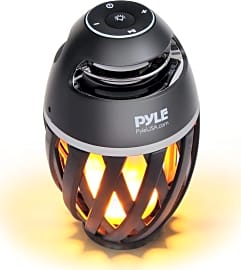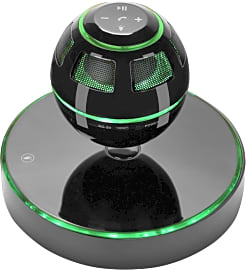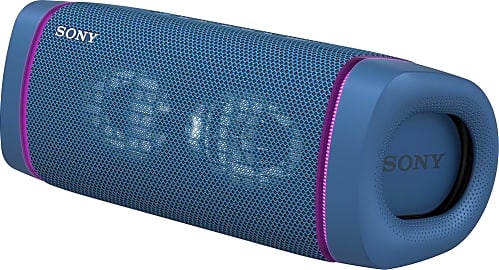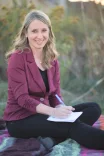The 10 Best Bluetooth Speakers With Lights

This wiki has been updated 32 times since it was first published in April of 2017. While there is a large selection of Bluetooth speakers to choose from, not all of them offer a built-in light show, like the ones featured here. Some are portable and inexpensive, while others are big and loud, but they can all add some fun illumination to the night's entertainment. We've ranked the top models based on how good they sound, how reliable they are, and how cool they look. When users buy our independently chosen editorial choices, we may earn commissions to help fund the Wiki.
Editor's Notes
November 03, 2020:
Today we added in the Ion Audio Raptor, a 100-watt water-resistant model available from one of the leading manufacturers of speakers. Ion speakers are well known for their innovative designs and rugged construction. This particular selection is larger than some of the others on this list, but it’s still made for portability, thanks to a telescoping pull handle, two side carrying handles, and wheels on the bottom. It’s thoughtfully designed with two built-in cupholders, so you can sit back and enjoy your favorite drink at the beach or in your backyard. It’s great for playing everything from your favorite songs to a sports broadcast, thanks to Bluetooth and NFC connectivity, an auxiliary input and another for a microphone, and an AM/FM radio. The user-friendly control panel features six radio station preset buttons, the Bluetooth pairing button, volume dials, and a power switch. The digital screen keeps you apprised of the battery’s charge status, and shows what radio station it’s set to. Finally, a multi-colored light bar can keep the fun going at night, as it can pulse to the music or stay on steadily. If you’re not in the mood for lights, simply turn it off. This new addition replaces the Via-Tek Water Dancing, which we removed due to availability issues.
We also replaced the Sony SRS-XB32 with the updated Sony SRS-XB33, which is redesigned and upgraded with a deeper base and a higher quality sound. It’s a great choice for a dorm room or an office, and incorporates strobe and multicolor LEDs to take your party to the next level. It joins the JBL PartyBox 300 on the list, which is a bit of an investment but a high-quality, reliable choice that can reach a high volume and creates a captivating light show. This versatile model can be powered via its battery or plugged into the wall or your vehicle’s 12-volt socket. In this update, we also decided to replace the Dikaou Atmosphere with the similar Pyle Candle Style, which is available from a more established name in speakers. It’s made to resemble a tiki torch, with warm yellow LEDs, and features a compact tabletop design. Its fully submersible build makes it suitable for either indoor or outdoor use, so it can help set the mood at your next backyard party.
June 21, 2019:
Bluetooth exists for one main purpose: convenience. And what's more convenient than a customizable light show built into a Bluetooth speaker? For that matter, what's more fun? The answer to both questions is "probably not much." If it's a big shindig you're outfitting, Sony makes a large, AC-powered model that's worth checking out, and JBL makes one that runs on your choice of three power sources. The Sony sounds a bit better, but the JBL is much louder and more versatile. The ProReck is in a similar style as those two, but it's quite a bit more affordable, at less than a third the price of either.
If you don't need quite that much volume, consider whether you're more into the sound or the lights. The JBL Pulse 3 actually offers both, and at a pretty good price considering the fact that it's closely related to the incredibly popular JBL Charge, and sounds almost as good. If you'd like to spend a little less, Sony and Anker both make highly portable options, though their LEDs aren't particularly fancy or bright. They do both sound pretty good, though.
If you want something that makes a decent amount of noise while looking really, really cool, we've got you covered there, too. The Uppel SC-26 will make sci-fi lovers giddy, the Via-Tek has a mesmerizing fountain inside, and the Outgeek Disco Ball is, well, a disco ball.
Finally, if you're looking for something to add a little atmosphere but not turn up the party, the Dikaou will do just that; it's a good way to add a little flame to your surroundings without having to light a fire.
What Is Bluetooth And How Does It Work?
Some of its common uses include transferring files between two devices, streaming audio through wireless speakers, and even playing multiplayer games.
Simply put, Bluetooth is a form of wireless communication technology that allows certain gadgets to connect with other compatible electronics nearby. It was designed specifically for communication across short distances, with most devices usually having a range of up to 30 feet. Some of its common uses include transferring files between two devices, streaming audio through wireless speakers, and even playing multiplayer games.
Bluetooth works by sending and receiving radio waves through antenna-equipped microchips. It operates in the unlicensed industrial, scientific, and medical radio band at around 2.4 to 2.485GHz. Bluetooth devices can communicate with each other as long as they're within range. In order to avoid unintentional interference, Bluetooth uses a technique called frequency hopping spread-spectrum. With FHSS, a pair of devices will constantly hop around different unused frequencies, sending small packets of data through each before switching to the next.
Aside from FHSS, Bluetooth devices also avoid interference by only consuming very little power. The downside to this feature is that Bluetooth tends to be very slow compared to Wi-Fi. Because of this, it is typically only used to reliably transfer a few megabytes worth of data at a time.
Whenever devices connect to one another through Bluetooth, they form what's called a piconet, which is a term used to describe a very small network. Bluetooth-capable gadgets can connect with up to seven different devices under a Master/Slave model, which basically means that one "master" device coordinates the communication between "slaves" within its own piconet. For example, if you connect your phone to a wireless speaker, your phone acts as the master that can transmit audio data to that speaker.
Choosing A Speaker With Lights
There are a few things you have to consider when choosing a Bluetooth speaker with lights. First of all, you have to figure out exactly what you're going to use the speakers for. For example, if you plan on using it for parties or large gatherings in general, you may want to get one of the bulkier models with a built-in subwoofer. If you need something that's portable, you should get one of the smaller speakers with rechargeable batteries that can last for several hours.
Finally, it should also be noted that most mobile devices can only stream through one audio device at a time.
Another thing you should consider is the type of light you need. Bluetooth speakers typically make use of programmable LED lights. Some of the major brands, such as JBL, manufacture speakers that support apps that let you customize how the lights are displayed and whether or not you want them to react to the music. There are also models designed to double as table lamps, which are perfect for people who want to play ambient music while they work or study.
You should also take note of what version of Bluetooth a speaker uses and whether or not it's compatible with whatever device you plan on pairing it with. Ideally, you'll want to get something that has Bluetooth 4.0 and above, because these devices are designed to consume much less power than their previous iterations without reducing their effective range. If you need something with more reach, you should consider buying a speaker that runs version 5.0, which has a range of over 200 meters.
Finally, it should also be noted that most mobile devices can only stream through one audio device at a time. There are a few speakers that have the ability to sync with at least one other speaker of the same brand though. If that's not an option, you can still sync two different audio devices if you're using a phone that has Bluetooth 5.0, because it will most likely have a "Dual Audio" option.
A Brief History Of Bluetooth
In 1989, a Swedish telecommunications company known as Ericsson started developing radio technology that allowed computers to interact with wireless headsets. By the mid-1990s, Ericsson engineers Jaap Haartsen and Sven Mattisson invented the MC-Link, which aimed to let devices interact with one another without using a cable. In order to operate worldwide, they had to make use of a license-free radio band. This means that unless they constantly hop frequencies, Bluetooth devices are prone to interference from several sources, such as microwave ovens and wireless phones.
In the same sense, their technology aimed to unite the wireless industry under one standard.
Throughout the decade, other companies (most notably, Nokia and Intel) started experimenting with the idea of short-range peer-to-peer connections between mobile devices and computers. Eventually, they realized that they needed to work on a universal standard so that devices from different companies could seamlessly connect with one other. In 1996, Ericsson, IBM, Intel, Toshiba, and Nokia formed the Bluetooth Special Interest Group or "SIG" for short. It's a non-profit organization that oversees the development and licensing of Bluetooth tech.
The name "Bluetooth" was proposed by an Intel engineer named Jim Kardach. When the companies first met to form the SIG, Kardach mentioned that he was reading a history book about Vikings that featured King Harald Bluetooth. Bluetooth was a king from the 10th century that managed to unite the many Scandinavian clans under one banner. In the same sense, their technology aimed to unite the wireless industry under one standard.
Bluetooth continues to develop over the years, with new versions being released every now and then. When the SIG first released Bluetooth 1.0, it was slow and riddled with compatibility issues. Since then, they've made significant improvements to its speed and range with every new version, and one can easily assume that this trend will continue as technology advances over time.





